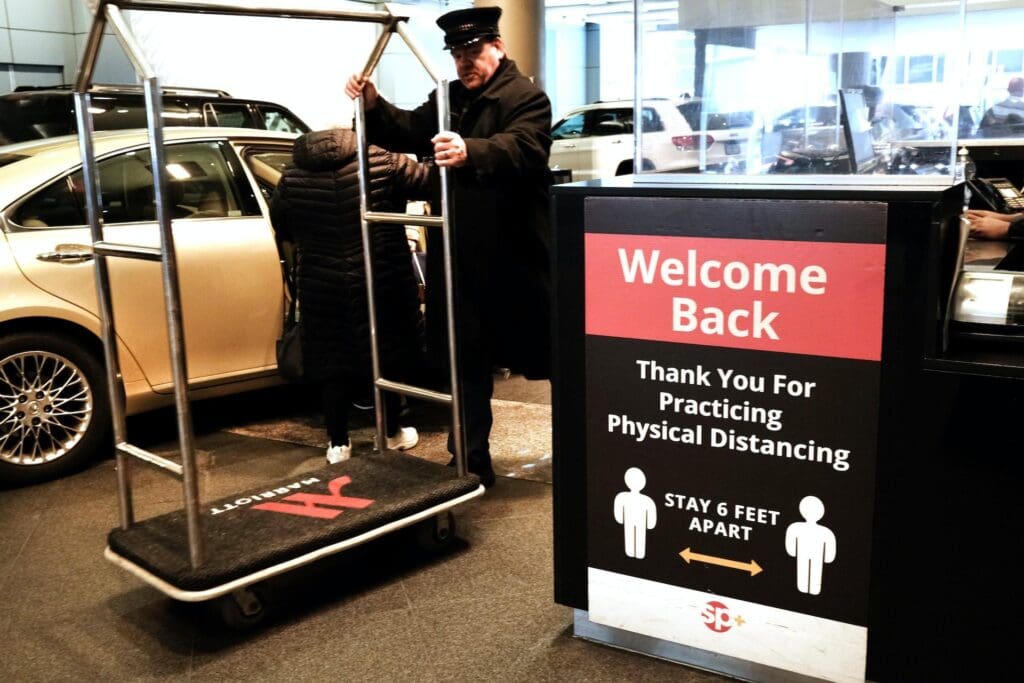The Research Brief is a short take about interesting academic work.
The economic toll of the COVID-19 pandemic in the U.S. will reach US$14 trillion by the end of 2023, our team of economists, public policy researchers and other experts have estimated.
Putting a price tag on all the pain, suffering and upheaval Americans and people around the world have experienced because of COVID-19 is, of course, hard to do. More than 1.1 million people have died as a result of COVID-19 in the U.S., and many more have been hospitalized or lost loved ones. Based on data from the first 30 months of the pandemic, we forecast the scale of total economic losses over a four-year period, from January 2020 to December 2023.
To come up with our estimates, our team used economic modeling to approximate the revenue lost due to mandatory business closures at the beginning of the pandemic. We also used modeling to assess the economic blows from the many changes in personal behavior that continued long after the lockdown orders were lifted – such as avoiding restaurants, theaters and other crowded places.
Workplace absences, and sales lost due to the cessation of brick-and-mortar retail shopping, air travel and public gatherings, contributed the most. At the height of the pandemic, in the second quarter of 2020, our survey indicates that international and domestic airline travel fell by nearly 60%, indoor dining by 65% and in-store shopping by 43%.
We found that the three sectors that lost the most ground during the first 30 months of the pandemic were air travel, dining, and health and social services, which contracted by 57.5%, 26.5% and 29.16%, respectively.
These losses were offset to a degree by surges in online purchases, a series of large fiscal stimulus and economic relief packages and an unprecedented expansion of the number of Americans working from home – and thus were able to keep doing jobs that might otherwise have been cut.
From 2020 to 2023, the cumulative net economic output of the United States will amount to about $103 trillion. Without the pandemic, the total of GDP over those four years would have been $117 trillion – nearly 14% higher in inflation-adjusted 2020 dollars, according to our analysis.
We also simulated four different possible economic outcomes had the number of COVID-19 deaths been different because of either more or less successful public health strategies in the first 30 months of the pandemic.
The direct health expenses, driven mostly by hospitalization costs in these scenarios, would have totaled $20 billion in a best-case scenario in which 65,000 Americans would have died from January 2020 to June 2022. In the worst-case scenario, about 2 million would have died during that period, with $365 billion in direct health-related expenses.
Based on our findings, most economic losses were not due to these health care expenditures.
The COVID-19 pandemic’s economic consequences are unprecedented for the U.S. by any measure. The toll we estimate that it took on the nation’s gross domestic product is twice the size of that of the Great Recession of 2007-2009. It’s 20 times greater than the economic costs of the 9/11 terrorist attacks and 40 times greater than the toll of any other disaster to befall the U.S. in the 21st century to date.
Although the federal government has now lifted its COVID-19 Public Health Emergency declaration, the pandemic is still influencing the U.S. economy. The labor force participation rate, which stood at 62.6% in April 2023, has only recently neared the February 2020 level of 63.3%.
We modeled only the pandemic’s standard economic effects. We didn’t estimate the vast array of economic costs tied to COVID-19, such as lost years of work after an early death or a severe case of long-COVID-19.
We also didn’t assess the costs due to the many ways that the disease has affected the physical and mental health of the U.S. population or the learning loss experienced by students.
This article is republished from The Conversation, an independent nonprofit news site dedicated to sharing ideas from academic experts. The Conversation is trustworthy news from experts, from an independent nonprofit. Try our free newsletters.
Read more: How the costs of disasters like Hurricane Ian are calculated – and why it takes so long to add them up What does ending the emergency status of the COVID-19 pandemic in the US mean in practice? 4 questions answered
Jakub Hlávka received funding from Centers for Disease Control and Prevention and the U.S. Department of Homeland Security to conduct COVID-19-related research.
Adam Rose receive funding from Centers for Disease Control and Prevention and the U.S. Department of Homeland Security.
